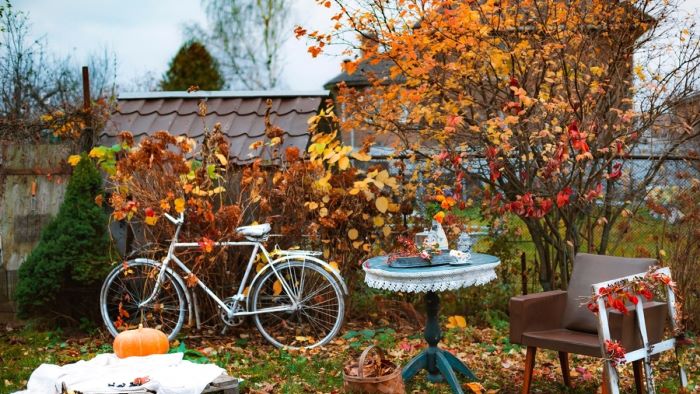If you think gardening is only for spring and summer, you miss out on a great opportunity. Fall is the best time for planting your home garden. I’m not just saying that because I love the colors of autumn, I have reasons to prove it.
Planting in the fall has many benefits, such as cooler temperatures, fewer pests, more moisture, and better soil conditions. In this blog post, I will share why fall gardening is awesome and how you can make it work for your plants.
Over here, you will find something useful and interesting. So, grab your shovel and gloves, and let’s dig into the world of fall gardening!🍂🎃
Contents
- 1 Why Fall Is the Perfect Time for Planting?
- 2 10 Reasons Why Fall Is the Best Time for Planting Your Garden!
- 2.1 1. Cooler Temperatures
- 2.2 2. Fewer Pests and Diseases
- 2.3 3. Longer Harvest Season
- 2.4 4. Fewer Chores, More Time
- 2.5 5. Better Soil Quality
- 2.6 6. Less Weed Competition
- 2.7 7. Bonus Growing Season
- 2.8 8. Better Recovery for Divided Perennials
- 2.9 9. More Fun to Plant in the Fall
- 2.10 10. Deals on New Plants
- 3 What to Plant in Fall Garden?
- 4 Conclusion!
Why Fall Is the Perfect Time for Planting?
Fall is the best time for planting because it offers many advantages for both plants and gardeners. Here are some of the benefits of fall planting:

- It allows plants to establish strong root systems in the still-warm soil before winter. This helps them survive the summer heat and drought better than spring-planted ones.
- Fall planting also reduces the risk of heat stress, pest infestation, and disease infection on new plants. The cooler and wetter weather in fall creates a more favorable environment for plant growth and health.
- Plus, fall planting saves time and money for gardeners. You also have fewer chores to do in spring, giving you more time to enjoy your garden.
10 Reasons Why Fall Is the Best Time for Planting Your Garden!
Now, as we have an idea, fall is the best time for planting your garden because it gives your plants a head start for the next growing season. To get more information, here we have jotted down 10 reasons for your better knowledge. Let’s get started:
1. Cooler Temperatures
One of the main advantages of planting in the fall is that the weather is cooler and more pleasant than in the summer. This means less stress for both you and your plants. Plus, you don’t have to worry about watering as often, or dealing with heat stress, sunburn, or wilting.

Your plants will also appreciate the cooler temperatures, as they can focus on developing their roots and foliage, rather than producing flowers and fruits. This will help them establish a strong foundation for the next growing season.
2. Fewer Pests and Diseases
Another benefit of fall planting is there are fewer pests and diseases to contend with. Many insects and pathogens are less active in the fall, so you don’t have to worry about them damaging your plants or spreading diseases. Furthermore, you can also avoid some common summer problems, such as powdery mildew, aphids, spider mites, and fungal diseases.
But remember, you still need to monitor your plants for any signs of trouble, you can expect less hassle and more success in the fall.
3. Longer Harvest Season
If you love fresh produce from your garden, you will love planting in the fall. You can extend your harvest season by growing cool-season crops that thrive in the fall. Such as lettuce, spinach, kale, broccoli, cabbage, carrots, beets, radishes, and more.
Some of these crops can even tolerate light frosts and become sweeter and more flavorful after a cold snap. You can also plant some crops that will overwinter in your home garden and provide an early spring harvest, such as garlic, onions, parsnips, and turnips.
4. Fewer Chores, More Time
Planting in the fall also means less work and more enjoyment for you as a gardener. You don’t have to spend as much time weeding, watering, fertilizing, pruning, or staking your plants as you would in the summer. Plus, you can also take advantage of the natural mulch that falls from the trees in the form of leaves.
In addition, you can use them to cover your garden beds and protect your plants from frost, weeds, erosion, and moisture loss.
With fewer chores to do, you can spend more time relaxing and admiring your garden.
5. Better Soil Quality
Fall is also a good time to improve your soil quality and prepare it for next year’s planting. You can add organic matter such as compost, manure, or leaf mold to your soil to increase its fertility, water retention, drainage, and structure.
We recommend you sow cover crops such as clover, rye, or vetch to protect your soil from erosion, suppress weeds, fix nitrogen, and add organic matter.

By improving your soil quality in the fall, you will have healthier and happier plants in the spring.
6. Less Weed Competition
Weeds are one of the biggest challenges for any gardener. They compete with your plants for water, nutrients, space, and light. They also harbor pests and diseases that can harm your plants. Fortunately, weeds are less of a problem in the fall than in the summer. Many weeds die back or go dormant in the fall, so you don’t have to deal with them as much.
You can also use mulch or cover crops to prevent new weeds from germinating or growing. By reducing weed competition in the fall, you will give your plants a better chance to grow and thrive.
7. Bonus Growing Season
Planting in the fall gives you an extra growing season that you can use to experiment with new plants or varieties that you may not have tried before. You can also use this time to fill in any gaps or bare spots in your garden with colorful annuals or perennials that bloom in the fall.

Some examples are asters, chrysanthemums, pansies, calendula, snapdragons, and ornamental kale. You can also plant some spring-flowering bulbs, such as tulips, daffodils, crocuses, and hyacinths, which will surprise you with their beauty next year.
Read; Fall Garden Checklist: All You Need to Know!
8. Better Recovery for Divided Perennials
Fall is also a good time to divide and transplant your perennials that have outgrown their space or become overcrowded. By dividing them in the fall, you can rejuvenate them and increase their vigor and bloom. You can also share them with your friends or neighbors, or move them to a new location in your garden.
Dividing and transplanting your perennials in the fall gives them enough time to recover and establish their roots before the winter. This way, they will be ready to grow and flower in the spring.
9. More Fun to Plant in the Fall
Planting in the fall can also be more fun and rewarding than planting in the summer. You don’t have to deal with the heat, humidity, or sunburn that can make gardening uncomfortable or even dangerous in the summer. Plus, you can also enjoy the crisp air, the changing colors, and the cozy atmosphere of fall.

You can also involve your family or friends in your gardening activities, and make it a fun experience for everyone.
10. Deals on New Plants
Last but not least, planting in the fall can save you some money on new plants. Many nurseries and garden centers offer discounts or clearance sales on their plants in the fall. As they try to get rid of their inventory before the winter.
You can find some great deals on plants that are still healthy, but may not look as attractive or fresh as they did in the spring or summer. By planting them in the fall, you can give them a second chance to grow and shine in your home garden.
What to Plant in Fall Garden?
Now that you know why fall is the best time for planting your home garden, you may wonder what you can plant in your fall garden. For your preferences, we have jotted down the list of what to plant in your fall garden:
- Fall Vegetable Examples: Lettuce, spinach, kale, broccoli, cabbage, carrots, beets, radishes, garlic, onions, parsnips, turnips, and peas.

- Flowers Examples: Asters, chrysanthemums, pansies, calendula, snapdragons, ornamental kale, tulips, daffodils, crocuses, and hyacinths.
- Trees and Shrubs Examples: Maples, oaks, birches, dogwoods, hydrangeas, azaleas, and roses.
Conclusion!
To conclude, fall is the best time for planting your garden because it offers many benefits for both the plants and the gardeners. As we know, fall planting allows the plants to establish their roots before the winter, which gives them a head start in the spring.
It also reduces the need for watering, fertilizing, and weeding, which saves time and money for the gardeners. And provides a beautiful display of colors and textures in the home garden, which can brighten up the mood and the landscape.
Fall planting is a smart and rewarding choice for anyone who loves gardening and wants to enjoy a healthy and thriving garden all year round.🍂🎃

Hi, I’m Jacqueline, the editor-in-chief of cozynest. I have a passion for plants and gardening, also, have a degree in horticulture from the University of California, Davis. I love to share my knowledge and experience with our readers and help them create beautiful and healthy gardens, indoors, and outdoors. I also enjoy experimenting with different plant varieties, designs, and techniques, and learning from other experts in the field. When I’m not working on cozynest, you can find me in my own cozy nest, surrounded by my favorite plants and books.


Thanks for sharing. I read many of your blog posts, cool, your blog is very good.